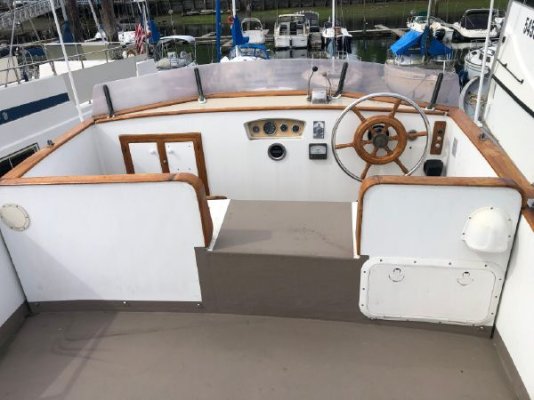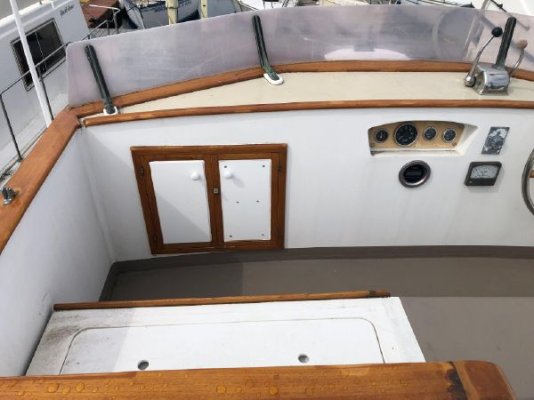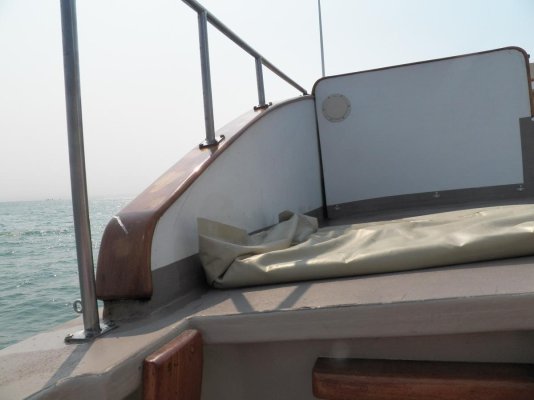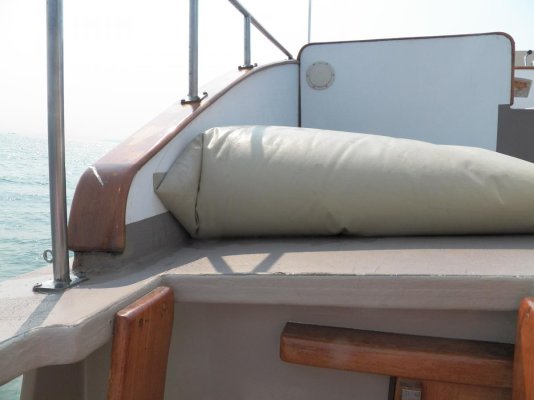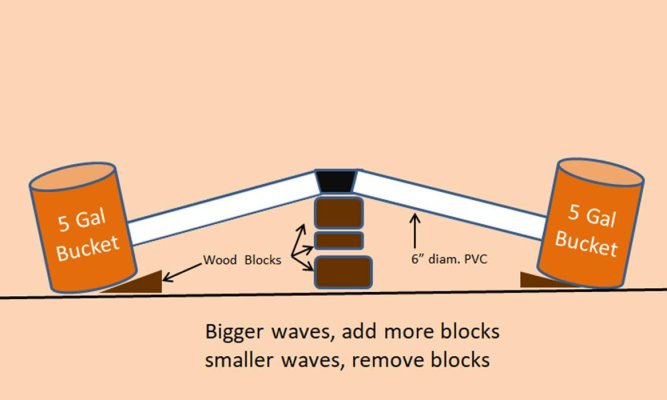Marco Flamingo
Guru
- Joined
- Jan 7, 2020
- Messages
- 1,173
- Location
- United States
- Vessel Name
- CHiTON
- Vessel Make
- Tung Hwa Clipper 30
I thought I would post this as a separate thread instead of occasionally commenting in other stabilization threads.
As with anchors, one’s choice of stabilization is based on the boat’s size, usage, location, etc., as well as the crew’s tolerance and the captain’s wallet. One of the things that made me think about putting in a stabilization tank is I may have the perfect place to install.
A prior owner had modified the seating on the flying bridge. Originally, the boat had the fairly common setup of a single helm box-seat starboard and a double seat port with a walkway between. Both boxes had access from the top. The modification had been to connect them (eliminating the walk-through) in order to install a long built-in cooler box in the port seat. It is kind of clunky to have to now climb over that area, but the PO must have thought that having a cold case of beer on the flying bridge was worth it. You can see the modified seat area (painted brown) in the pictures below. The top opening on the port side seat is the the ice box extending into the middle section. So I already have a 24” x 16” x 102” area for an anti-roll tank.
Experimenting with the bag came about because I was curious to see what, if anything, was the effect of having water moving around on the FB. I had read a few studies regarding “free surface” water tanks and it is generally the case that free surface water waves travel side-to-side faster than the roll period of the boat. The basic idea is, say when the boat rolls to port, the water in the tank will also roll to that side, but it needs to “arrive” a fraction of a second after the boat begins to recover. That extra weight, now having been transferred to the port side just when the port side is lifting, is the whole ballgame.
This is an old concept. Lord Kelvin presented a paper over a century ago on the effectiveness of a free-surface water tank on a vessel’s deck. At the time, a new sailing vessel was often “rolled” at anchor to determine various weaknesses and remedy them best as possible. 20 men would run synchronously back and forth on the deck to induce a roll and the roll period, angle, attenuation, etc., would be noted. Very scientific, right? Of course, the vessel had already been designed and built (where the issues could really be addressed), but some changes to ballast and rigging might be possible. The addition of a free surface water-filled tank on deck was surprisingly effective stabilization. (I have done the same testing at the dock with my anti-roll bag.)
Over the years, changes to the anti-roll tank’s placement, shape, internal baffles, etc. have been tried to increase the effectiveness. There are also tanks which are not “free surface” and have constrictions, pressurized air, water pumps, etc. to increase effectiveness. Of course, the more complex the system, usually called “active” systems, the more likely the system can fail. There is a famous “wreck dive” on a ship that had an active stabilization tank malfunction on its maiden voyage. A glitch caused the water in the tank to shift to the point that the ship simply rolled over and sank. This incident probably helped perpetuate the "hair on fire" reaction some have to the idea of shifting water for stabilization. A 700# dinghy, two kayaks, a freezer, and 4 obese Americans on the FB is okay. 500# of water? No way!
As with anchors, one’s choice of stabilization is based on the boat’s size, usage, location, etc., as well as the crew’s tolerance and the captain’s wallet. One of the things that made me think about putting in a stabilization tank is I may have the perfect place to install.
A prior owner had modified the seating on the flying bridge. Originally, the boat had the fairly common setup of a single helm box-seat starboard and a double seat port with a walkway between. Both boxes had access from the top. The modification had been to connect them (eliminating the walk-through) in order to install a long built-in cooler box in the port seat. It is kind of clunky to have to now climb over that area, but the PO must have thought that having a cold case of beer on the flying bridge was worth it. You can see the modified seat area (painted brown) in the pictures below. The top opening on the port side seat is the the ice box extending into the middle section. So I already have a 24” x 16” x 102” area for an anti-roll tank.
Experimenting with the bag came about because I was curious to see what, if anything, was the effect of having water moving around on the FB. I had read a few studies regarding “free surface” water tanks and it is generally the case that free surface water waves travel side-to-side faster than the roll period of the boat. The basic idea is, say when the boat rolls to port, the water in the tank will also roll to that side, but it needs to “arrive” a fraction of a second after the boat begins to recover. That extra weight, now having been transferred to the port side just when the port side is lifting, is the whole ballgame.
This is an old concept. Lord Kelvin presented a paper over a century ago on the effectiveness of a free-surface water tank on a vessel’s deck. At the time, a new sailing vessel was often “rolled” at anchor to determine various weaknesses and remedy them best as possible. 20 men would run synchronously back and forth on the deck to induce a roll and the roll period, angle, attenuation, etc., would be noted. Very scientific, right? Of course, the vessel had already been designed and built (where the issues could really be addressed), but some changes to ballast and rigging might be possible. The addition of a free surface water-filled tank on deck was surprisingly effective stabilization. (I have done the same testing at the dock with my anti-roll bag.)
Over the years, changes to the anti-roll tank’s placement, shape, internal baffles, etc. have been tried to increase the effectiveness. There are also tanks which are not “free surface” and have constrictions, pressurized air, water pumps, etc. to increase effectiveness. Of course, the more complex the system, usually called “active” systems, the more likely the system can fail. There is a famous “wreck dive” on a ship that had an active stabilization tank malfunction on its maiden voyage. A glitch caused the water in the tank to shift to the point that the ship simply rolled over and sank. This incident probably helped perpetuate the "hair on fire" reaction some have to the idea of shifting water for stabilization. A 700# dinghy, two kayaks, a freezer, and 4 obese Americans on the FB is okay. 500# of water? No way!

